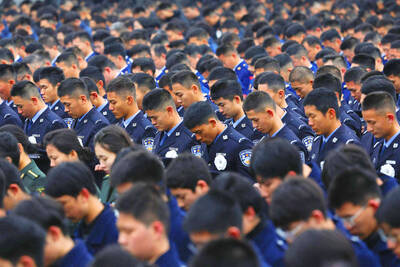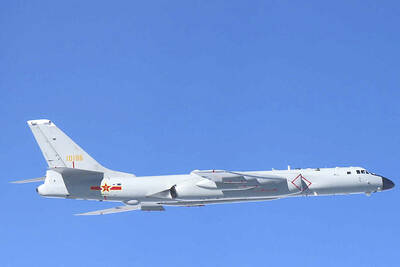The top political leader of China’s vast northern region of Inner Mongolia had a meeting with local students in a bid to placate public anger, state media reported, after the hit-and-run death of a herder sparked six days of protests by ethnic Mongolians.
In the first response from the Chinese Communist Party (CCP) to the demonstrations, Inner Mongolia’s CCP chief Hu Chunhua (胡春華) told students and teachers on Friday that he was representing the government to seek their views on the situation and said “public anger has been immense.”
“Please be assured, teachers and students, that the suspects ... will be punished severely and quickly, so that the ... rights of victims and their families can be resolutely safeguarded,” the Inner Mongolian Daily cited Hu as saying.
PUBLIC ANGER
Hundreds of Mongolian herders and students have taken to the streets, angered by the death this month of a herder, Mergen, after being struck by a coal truck. The government announced the arrest of two Han Chinese for homicide, but that failed to stem public anger.
China sealed off parts of Inner Mongolia, a resource-rich region strategically located on the borders of Russia and Mongolia, after the demonstrations.
Some residents said parts of Inner Mongolia had been placed under “martial law.”
CLASH, DEATH
In a separate incident, one man died four days later after residents of Abaga Banner, or county, in Inner Mongolia clashed with coal miners because of complaints of pollution from the mines.
Hu said “we must correctly handle the relationship between the exploration of resources and the protection of the interests of people” in Inner Mongolia, China’s largest producer of coal.
“In the development process, it is necessary that safeguarding the interests of the masses must be the fundamental starting point,” Hu was quoted as saying in the report.
MONGOL TREATMENT
Mongolians, who make up less than 20 percent of the roughly 24 million population of the Inner Mongolian Autonomous Region, rarely take to the streets, unlike Tibetans or Xinjiang’s Uighurs, making the latest protests highly unusual.
Inner Mongolia, which covers more than a tenth of China’s land mass and borders Mongolia proper, is supposed to offer a high degree of self-rule, but Mongolians say the Han majority run the show and have been the main beneficiaries of economic development.

PARLIAMENT CHAOS: Police forcibly removed Brazilian Deputy Glauber Braga after he called the legislation part of a ‘coup offensive’ and occupied the speaker’s chair Brazil’s lower house of Congress early yesterday approved a bill that could slash former Brazilian president Jair Bolsonaro’s prison sentence for plotting a coup, after efforts by a lawmaker to disrupt the proceedings sparked chaos in parliament. Bolsonaro has been serving a 27-year term since last month after his conviction for a scheme to stop Brazilian President Luiz Inacio Lula da Silva from taking office after the 2022 election. Lawmakers had been discussing a bill that would significantly reduce sentences for several crimes, including attempting a coup d’etat — opening up the prospect that Bolsonaro, 70, could have his sentence cut to

China yesterday held a low-key memorial ceremony for the 1937 Nanjing Massacre, with Chinese President Xi Jinping (習近平) not attending, despite a diplomatic crisis between Beijing and Tokyo over Taiwan. Beijing has raged at Tokyo since Japanese Prime Minister Sanae Takaichi last month said that a hypothetical Chinese attack on Taiwan could trigger a military response from Japan. China and Japan have long sparred over their painful history. China consistently reminds its people of the 1937 Nanjing Massacre, in which it says Japanese troops killed 300,000 people in what was then its capital. A post-World War II Allied tribunal put the death toll

A passerby could hear the cacophony from miles away in the Argentine capital, the unmistakable sound of 2,397 dogs barking — and breaking the unofficial world record for the largest-ever gathering of golden retrievers. Excitement pulsed through Bosques de Palermo, a sprawling park in Buenos Aires, as golden retriever-owners from all over Argentina transformed the park’s grassy expanse into a sea of bright yellow fur. Dog owners of all ages, their clothes covered in dog hair and stained with slobber, plopped down on picnic blankets with their beloved goldens to take in the surreal sight of so many other, exceptionally similar-looking ones.

‘UNWAVERING ALLIANCE’: The US Department of State said that China’s actions during military drills with Russia were not conducive to regional peace and stability The US on Tuesday criticized China over alleged radar deployments against Japanese military aircraft during a training exercise last week, while Tokyo and Seoul yesterday scrambled jets after Chinese and Russian military aircraft conducted joint patrols near the two countries. The incidents came after Japanese Prime Minister Sanae Takaichi triggered a dispute with Beijing last month with her remarks on how Tokyo might react to a hypothetical Chinese attack on Taiwan. “China’s actions are not conducive to regional peace and stability,” a US Department of State spokesperson said late on Tuesday, referring to the radar incident. “The US-Japan alliance is stronger and more